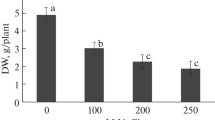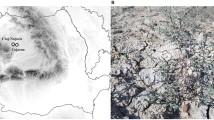Summary
Sesbania showed a luxuriant growth in soil with an electrical conductivity of up to 10 m Scm−1. Under saline conditions Na and Cl accumulated at different rates in the plants. Accumulation of these ions in the leaf rachis compared with leaflets appears to be an adaptive feature of this legume. Maintenance of an optimum K level and accumulation of Ca are also indicative of a salt-tolerance mechanism. Accumulation of Fe in the roots of salt-stressed plants is noteworthy. Organic acids and soluble sugars which accumulated in plants under stress condition may play a role in osmotic adjustment. The level of proline, however, remained unaltered. Though the chlorophyll content of the leaves decreased, the photosynthetic rate was found to be enhanced by saline conditions. The probable relationships between these changes and the salt tolerance mechanism in the plant have been discussed.
Similar content being viewed by others
References
Ackerson R C and Youngner V B 1975 Response of Bermuda grass to salinity. Agron. J. 67, 678–681.
Arnon D I 1949 Copper enzymes in isolated chloroplasts, polyphenol oxidase inBeta vulgaris. Plant Physiol. 24, 1–15.
Bates L S, Waldren P and Teare I D 1973 Rapid determination of free proline for water stress studies. Plant and Soil 39, 205–207.
Bernstein L 1956 Salt tolerance of field crops. United States Salinity Laboratory Report to Collaborators, Riverside, California, 33–34.
Bernstein L 1975 Effect of salinity and sodicity on plant growth. Ann Rev. Phytopath. 13, 295–312.
Clarkson D T and Hanson J B 1980 The mineral nutrition of higher plants. Ann. Rev. Plant Physiol. 31, 239–298.
Dirr M A 1974 Tolerance of honey locust seedlings to soil applied salt. Hort. Sci. 9, 53–54.
Downton W J S 1977 Chloride accumulation in different species of grapevine. Sci. Hortic. 7, 249–253.
Drosdoff M and Nearpass G D 1948 Quantitative microdetermination of magnesium in plant tissues and soil extracts. Anal. Chem. 20, 673–674.
Durie R A, Schaffer H N S and Swaine D J 1965 Technical communication 47, Commonw. Sci. Ind. Res. Org. Techn. Commun. 47, 33–37.
Epstein E 1972 Mineral Nutrition of Plants: Principles and Perspectives. John Wiley and Sons Inc., New York.
Epstein E 1980In Genetic Engineering of Osmoregulation. Impact on Plant Productivity for Food, Chemicals and Energy pp 7–21 Eds. D W Rains, C Valentine and A Hollander. Plenum Press, London.
Flowers T J, Troke P F and Yeo A R 1977 The mechanism of salt to lerance in halophytes. Ann. Rev. Plant Physiol. 28, 89–121.
Gabriels Jr R 1972 Tolerance aux selo des cultures agricoles et horticoles. Revue de 1. “Agriculture”. 1, 53–72.
Gorham J, McDonnel E and Wyn Jones R G 1984 Pinitol and other solutes in salt stressedSesbania aculeata. Z. Pflanzenphysiol. 114, 173–178.
Grant D M and Somers G F 1981 Salinity, aeration and the growth ofKosteletzkya virginica. Plant Physiol. (Suppl.) 67, 18.
Hawk P B, Oser B L and Summerson W H 1948In Practical Physiological Chemistry. The Blakiston Company, U.S.A.
Joshi G V 1976 Studies in Photosynthesis under Saline Conditions. PL 480 Project Report, Shivaji University, Kolhapur, India.
Kanwar J S, Bhumbla D R and Singh N T 1965 Studies on the reclamation of saline and sodic soils in Punjab. Indian J. Agric. Sci. 35, 43–51.
Karadge B A and Chavan P D 1984 Physiological studies in salinity tolerance ofSesbania aculeata Poir. Biol. Plant. 25, 412–418.
Lauchli A and Wieneke J 1979 Studies on the growth and distribution of Na+, K+ and Cl− in soybean varieties differing in salt tolerance. Z. Pflanzenernahr. Bodenk. 142, 3–13.
Maas E V and Hoffman G J 1976 Crop salt tolerance: Current Assessment. ASCE. J. Irrig. Drainage. Div. 103, 115–135.
Maas E V, Ogata G and Garber M J 1972 Influence of salinity on Fe, Mn and Zn uptake by plants. Agron. J. 64, 793–795.
Marschner H, Kylin A and Kuiper P J C 1981 Difference in salt tolerance of three sugar beet genotypes. Physiol. Plant. 51, 234–238.
Nelson N 1944 A photometric adaptation of the Somogyi method for the determination of sugars. J. Biol. Chem. 153, 375–380.
Nieman R H 1962 Some effects of sodium chloride on growth, photosynthesis and respiration of twelve crop plants. Bot. Gaz. 123, 279–285.
Petolino J F and Leone I A 1980 Saline aerosol: Some effects on the physiology ofPhaseolus vulgaris (Cultivar Toporop). Phytopathol. 70, 225–232.
Rush D W and Epstein E 1976 Genotypic responses to salinity. Difference between salt sensitive and salt tolerant genotypes of tomato. Plant Physiol. 57, 162–166.
Sekine T, Sasakawa T, Morita S, Kimara T and Kuratomi K 1972In Laboratory Manual for Physiological studies of rice. Eds. S. Yoshida, D. Forno, J.N. Cook and K.A. Gomez. Publ. by Inrenational Rice Research Institute, Manila.
Sharadadevi C, Rao G G and Rao G R 198014CO2 incorporation studies under salt stress in safflower (Carthamus tinctorius L.). J. Nuclear. Agric. Biol. 9, 129–132.
Strogonov B P, Kabanov V V, Shevjakova N I, Lapina L P, Komizerko E I, Popov B A, Dostanova R Kh and Prykhod'Ko L S 1970 Structure and Function of Plant Cells under Salinity. Moscow, Nauka.
Svitsev M V, Ponnamoreva S A and Kuznestova E A 1973 Effect of salinization and herbicides on chlorophyllase activity in tomato leaves. Fiziol. Rast. 20, 62–65.
Tal M 1971 Salt tolerance in the wild relatives of the cultivated tomato: Responses ofLycopersicon esculentum, L. peruvianum and L. esculentum minor in NaCl salinity. Aust. J. Agric. Res. 22, 631–638.
Thomas M and Beevers H 1949 Physiological studies in acid metabolism in gren plants. III. Evidence of CO2 fixation inBryophyllum calycinum and the study of diurnal variation in the genus. New. Phytol. 48, 421–447.
Tiku B L 1976 Effect of salinity on the photosynthesis of the halophytesSalicornia rubra andDistichlis stricta. Physiol. Plant. 37, 23–28.
Townsend A M 1980 Response of selected tree species to sodium chlorides. J. Amer. Soc. Hort. Sci. 105, 878–883.
Volhard A 1956 ChloridesIn Modern methods of plant analysis. K Peach and Tracey M V (ed.), Springer-Verlag Publ. Berlin 1, pp. 487.
Author information
Authors and Affiliations
Rights and permissions
About this article
Cite this article
Chavan, P.D., Karadge, B.A. Growth, mineral nutrition, organic constituents and rate of photosynthesis inSesbania grandiflora L. grown under saline conditions. Plant Soil 93, 395–404 (1986). https://doi.org/10.1007/BF02374290
Received:
Revised:
Issue Date:
DOI: https://doi.org/10.1007/BF02374290




